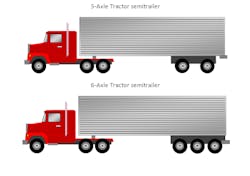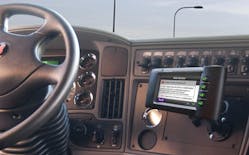Increasing federal truck size-and-weight limits and granting more exemptions from the electronic logging device (ELD) mandate were among the recommendations manufacturing groups sent to the Trump administration.
About 170 comments were posted to regulations.gov in response to an executive order signed by President Trump during his first week in office aimed at “streamlining permitting and reducing regulatory burdens for domestic manufacturing.”
The comments were filed to the U.S. Commerce Secretary Wilbur Ross, who must submit a plan of action to the president by the end of May.
The Environmental Protection Agency (EPA) drew the most criticism, with many of the filings focusing on non-transportation concerns.
However, a number of associations clearly believe the current federal limit of 80,000 lbs. must be raised.
For example, a joint filing from the American Forest and Paper Association (AFPA), the Beer Institute, and the Agriculture & Commodities Transportation Coalition urged the modernization of federal truck weight limits to “make this country a more attractive site” for manufacturing. The AFPA said an increase to 91,000 lbs. with use of an additional trailer axle would cut as many as 1.4 million truck trips annually and reduce annual truck miles by as much as 250 million.“This single reform has the potential to generate huge cost savings for U.S. businesses and improve the outlook for manufacturing jobs in the United States,” the groups wrote.
While they did not explicitly state their weight preference, they made multiple references to a limit of 91,000 lbs.
Calling transportation “one of the most significant costs” for its members, the Composite Panel Association encouraged the Trump administration to work with Congress to approve the 91,000-lb. limit. It noted several states including Wisconsin already have changed laws to accommodate higher weights.
Domtar, a manufacturer of wood fiber-based products, requested raising the limit to 97,000 lbs. Domtar said the current limit creates inefficiencies for companies like itself, which haul heavy paper products. It has to use half-empty trucks because the “weight limit is reached long before the physical capacity of the tractor-trailer is reached.”
Current weight rules are “stuck in the last century, as they fail to account for significant improvements in vehicle safety and pavement technology,” Domtar said.
Also speaking out on truck productivity was the National Association of Manufacturers (NAM), which asked the Department of Transportation (DOT) to study the cost-benefit and safety analysis of both 91,000-lb. vehicles and twin 33-ft. trailers.The need for longer and/or heavier trucks is a topic that’s seeing new life on several fronts of late. For example, John Larkin – managing director and head of transportation capital markets research for Stifel Capital Markets – noted that the issue came up during his visit to the annual meeting of the National Strategic Shippers Transportation Council (NASSTRAC) last week.
“The logic to make … existing power units more productive may well overwhelm the emotional notion that 33-ft. trailers must be more unsafe than 28’s [28-ft. units],” he said in a research note.
“One participant expressed the thought that the feds should not stop with 33’s but should look at other size and weight combinations that are consistent with the [federal] bridge formula (used to design and build bridges on our interstate system) and [that] therefore would not accelerate the rate of pavement and bridge deterioration. “
Larkin added that the longer vehicle configurations that should be evaluated include three-axle semi-trailers, turnpike twins, triple 28’s, Rocky Mountain doubles, etc.
“The broad adoption of more far-reaching changes in truck size and weight laws would make high-quality drivers more productive, reduce the number of trucks on the road, reduce the need for new highway capacity, etc.,” he emphasized.
Turning back to recommendations, NAM also wants the Federal Motor Carrier Safety Administration (FMCSA) to identify ways to minimize unnecessary burdens and costs as the final rule requiring commercial drivers to use ELDs to record hours of service (HOS) data goes into effect in December this year. As an example, it suggested an exemption for livestock haulers.The Associated General Contractors of America wants a similar exemption for construction drivers, while the Treated Wood Council requested that small businesses - “under 25 trucks” - be granted an exemption.
Offering more HOS flexibility for construction and other short-haul drivers was recommended in comments filed by the American Road & Transportation Builders Association.
Looking deeper at the HOS rule, NAM pointed to the mandatory 30-minute break within the first eight hours of driving as another measure worth a fresh review. It also called on the expansion of truck parking facilities to ensure truckers can safely meet rest regulations.
NAM’s 42-page filing left almost no stone unturned. From streamlining the testing of heavy-duty engines between EPA and California, tweaking the Food Safety Modernization Act, providing for a mid-term evaluation of fuel economy rules for light-duty vehicles and ensuring a coordinate government process when developing autonomous driving guidelines to avoid conflicts, there were more than a dozen freight transportation suggestions offered up.
The association was among several calling for the suspension or elimination of the conflict minerals rule established by the Securities and Exchange Commission (SEC). Aimed at preventing the use of certain minerals originating in the Democratic Republic of Congo and neighboring countries, publicly traded manufacturers said it is a costly and nearly impossible task, especially for small firms that supply to larger ones.
Earlier this month, the SEC said it is considering options after a court declared the rule violates the First Amendment of the Constitution.
Another item that drew the ire of multiple commenters was an Obama administration rule making many more workers eligible for overtime pay. However, a U.S. District Court in Texas issued a temporary injunction in November, preventing it from taking effect and giving the Trump administration until May to determine its position. It would have doubled to $47,476 the salary a worker could make and be eligible for overtime pay.






